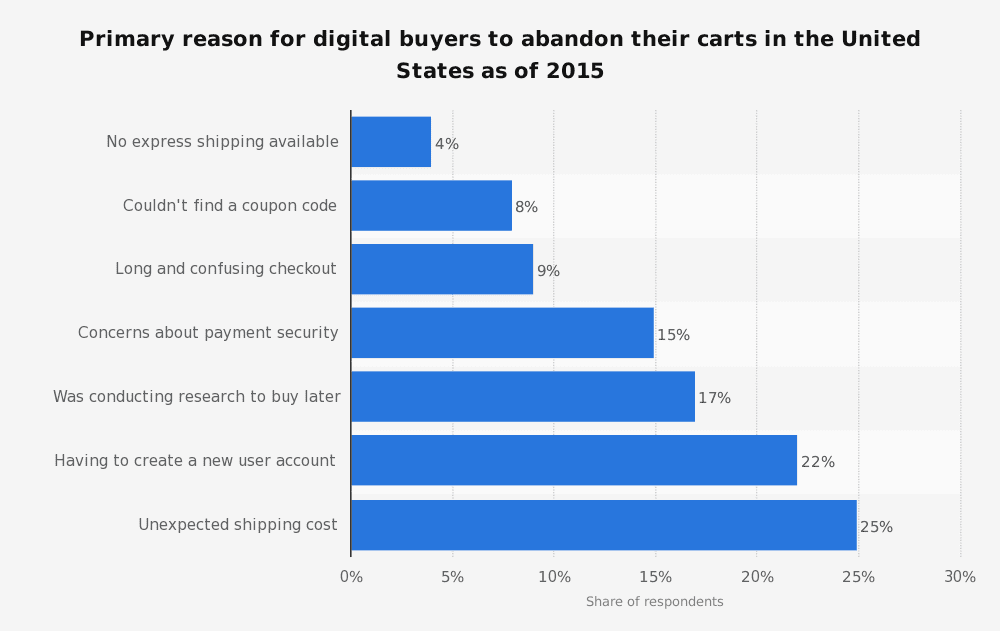How to Get Cart Abandoners to Close the Deal

Are you sitting down? We’ve got some bad news.
Right now, cart abandonment costs retailers an estimated $4 trillion per year.
Rough, right?
For lots of consignment store owners, this cart abandonment rate might feel like a harsh fact. Like there’s nothing you can do about it, no step you can take to control it, and few actions you can take to alter the structure of it at all.
Fortunately, that’s not as true as it might seem.
While some level of cart abandonment will always be a reality for online businesses, there are steps you can take to prevent cart abandonment as much as possible, or at least reduce impact of cart abandonment your store suffers. In addition to boosting your sales, this is one of the easiest ways to set yourself and your business up for long-term success.
Here’s what you need to know about the history of cart abandonment, and methods you can use to defeat cart abandonment once and for all.
What Makes Cart Abandoners Tick?
Baymard reports that customers abandon about 68% of all online shopping carts. This means that more than half of the people who put an item in their cart will leave your website without purchasing it.
But why?
What drives cart abandonment? And how can you limit it to drive more sales? Here are a few of the top reasons people leave websites without checking out:
- Undesirable shipping options. 4% of people abandon their online carts because there’s no express shipping available. This is a major let-down for people who need their items quickly or who are purchasing gifts.
- High prices. Not being able to find a coupon code will cause 8% of people to abandon their carts.
- Confusing checkout process. This is a no-no among customers and will cause 9% of people to leave your site.
- Account requirement. If a customer needs to create a user account to check out on your site, 22% of people will abandon their carts.
- High shipping costs. 25% of people will leave a website if the shipping cost associated with it is too high.

5 Ways to Reduce Cart Abandonment
If those statistics have you feeling all doom-and-gloom about ecommerce, don’t worry – there are steps you can take to reduce cart abandonment and drive more sales.
Here are a few actionable tips your store can implement now:
1. Use Email Retargeting
Email retargeting is the anecdote to cart abandonment. Retargeting works by embedding cookies in email messages and displaying ads to users as they browse the web.
Ideal for bringing customers back after they’ve abandoned a cart, email retargeting is highly focused and more effective than many of the other options you’ll come across.
1. Build Your Community
This is sales 101. Before you can push a product successfully, you’ve got to create a sense of community around your product.
This is the one real place that a brick-and-mortar store has an advantage on a digital establishment: the brick-and-mortar has customers walking through the door, and that makes it much easier to create a sense of community.
Don’t worry, though: you can create this sense of community even without a physical home base.
By utilizing Facebook as a platform to share local news, provide information, and connect deeply with your customers, you can build up a trusting and engaged community that makes it easier to sell your goods down the road.
2. State All Costs Upfront
Customers hate being surprised by additional shipping costs. In fact, 56% of consumers who abandon their carts do so because they were presented with unexpected costs during checkout. Because of this, it’s essential to make them aware of any additional costs their orders will incur, and why.
Moreover than this, it’s critical to avoid these additional costs as much as possible and to keep your shipping and order costs simple, low, and straightforward.
3. Send Follow-Up Emails
Right after a customer abandons a cart, send a follow-up email. Just because someone has left your site doesn’t mean you’ve lost them forever. In fact, you still have a few hours to draw them back in. According to Neil Patel, here’s how follow-up emails affect conversion rates:
- 30% of customers purchase within 20 minutes
- 50% purchase within 20 minutes
- 60% purchase in 1-3 hours
- 65% purchase in 3-12 hours
4. Offer a Guest Checkout
The more you can reduce sign-in barriers, the better. When you force customers to create a user account to purchase your products, you set yourself up for high abandonment rates and ongoing disappointment.
Remember: customers love streamlined checkout processes. If an account is an absolute requirement for your store, use social sign-in to simplify the process.
5. Integrate Progress Indicators
When they’re checking out from your store, customers don’t exactly want to feel like they’re running a marathon.
With this in mind, consider offering clear progress indications that show your customers exactly how far along they are in the checkout process. The forward momentum such a visual will create can help drive customers through the funnel and may boost your conversion rates.
Start Reducing Abandonment Today
Nobody likes cart abandonment, but, until now, there’s been an ongoing assumption that there’s not much you can do about it. Fortunately, that’s not entirely true. While there will always be a customer somewhere who abandons their carts on your website, despite your best efforts, you can take proactive steps to reduce cart abandonment and drive more sales from your digital storefront.
While cart abandonment is frustrating, it owes to simple and easy-to-fix reasons. If customers are leaving because your shipping rates are too high, the answer is simply to reduce your shipping costs and streamline the process. If customers are leaving because they have to create an account to shop with you, offering social sign-in can go a long way to help.
No matter who you are or what kind of business you run, reducing cart abandonment rate is one of the most important things you can do to ensure the success of your company. So, what are you waiting for? Get out there and send your customers home with full carts!
Need even more tips? We’ve got you covered with this illustrated infographic about cart abandonment rates.

Share On:








